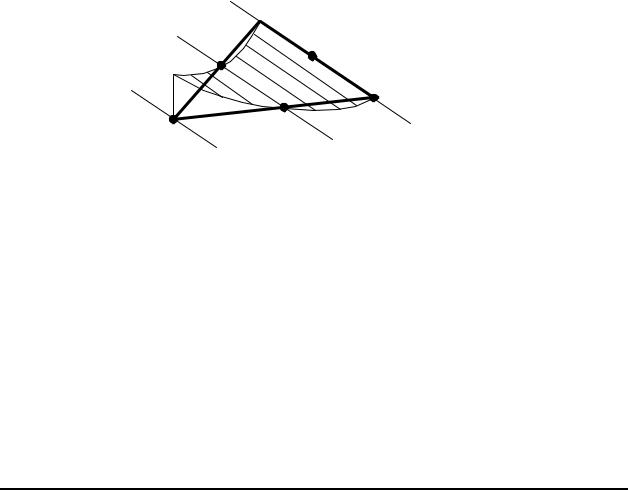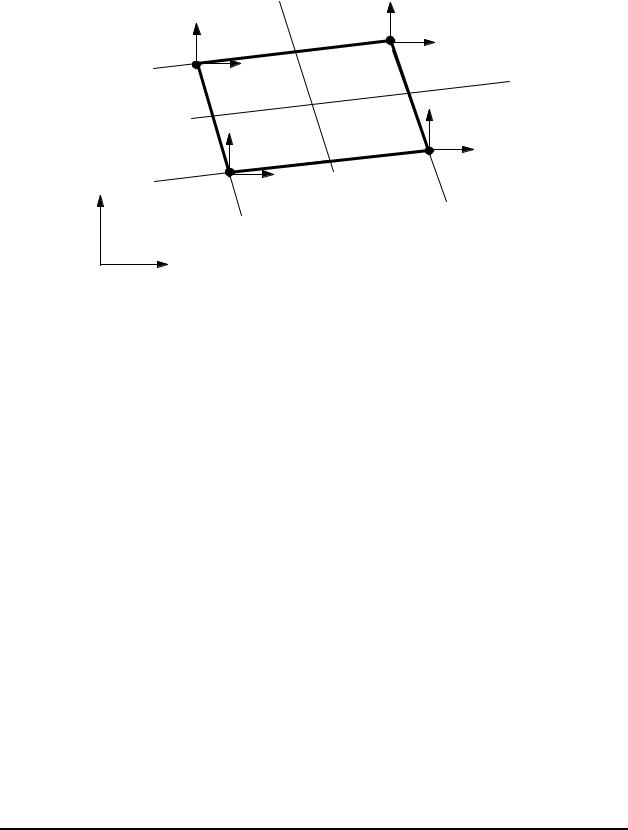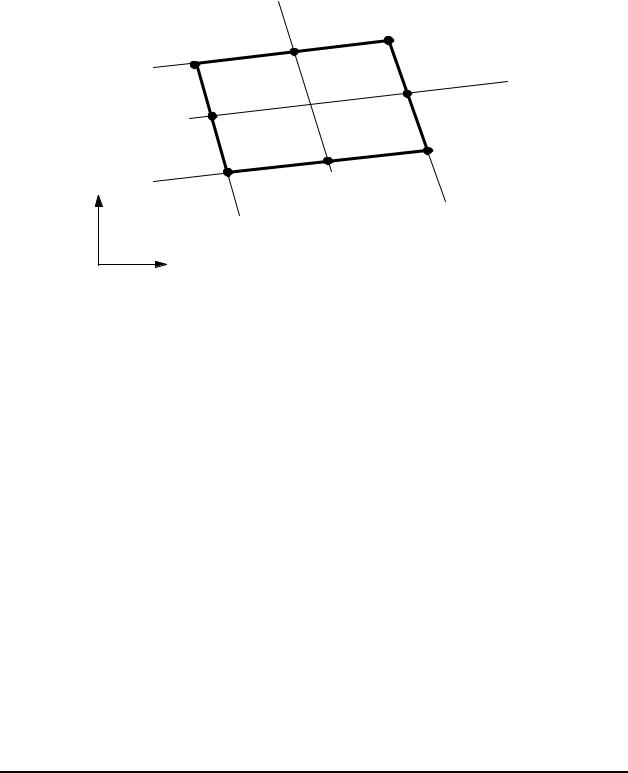
- •Copyright Notice
- •Table of Contents
- •Chapter 1. Introduction
- •I. Basic Concepts
- •Examples:
- •Why Finite Element Method?
- •Applications of FEM in Engineering
- •Examples:
- •A Brief History of the FEM
- •FEM in Structural Analysis (The Procedure)
- •Example:
- •Available Commercial FEM Software Packages
- •Objectives of This FEM Course
- •II. Review of Matrix Algebra
- •Linear System of Algebraic Equations
- •Matrix Addition and Subtraction
- •Scalar Multiplication
- •Matrix Multiplication
- •Transpose of a Matrix
- •Symmetric Matrix
- •Unit (Identity) Matrix
- •Determinant of a Matrix
- •Singular Matrix
- •Matrix Inversion
- •Examples:
- •Solution Techniques for Linear Systems of Equations
- •Positive Definite Matrix
- •Differentiation and Integration of a Matrix
- •Types of Finite Elements
- •III. Spring Element
- •One Spring Element
- •Spring System
- •Checking the Results
- •Notes About the Spring Elements
- •Example 1.1
- •Chapter 2. Bar and Beam Elements
- •I. Linear Static Analysis
- •II. Bar Element
- •Stiffness Matrix --- Direct Method
- •Stiffness Matrix --- A Formal Approach
- •Example 2.1
- •Example 2.2
- •Distributed Load
- •Bar Elements in 2-D and 3-D Space
- •2-D Case
- •Transformation
- •Stiffness Matrix in the 2-D Space
- •Element Stress
- •Example 2.3
- •Example 2.4 (Multipoint Constraint)
- •3-D Case
- •III. Beam Element
- •Simple Plane Beam Element
- •Direct Method
- •Formal Approach
- •3-D Beam Element
- •Example 2.5
- •Equivalent Nodal Loads of Distributed Transverse Load
- •Example 2.6
- •Example 2.7
- •FE Analysis of Frame Structures
- •Example 2.8
- •Chapter 3. Two-Dimensional Problems
- •I. Review of the Basic Theory
- •Plane (2-D) Problems
- •Stress-Strain-Temperature (Constitutive) Relations
- •Strain and Displacement Relations
- •Equilibrium Equations
- •Exact Elasticity Solution
- •Example 3.1
- •II. Finite Elements for 2-D Problems
- •A General Formula for the Stiffness Matrix
- •Constant Strain Triangle (CST or T3)
- •Linear Strain Triangle (LST or T6)
- •Linear Quadrilateral Element (Q4)
- •Quadratic Quadrilateral Element (Q8)
- •Example 3.2
- •Transformation of Loads
- •Stress Calculation
- •I. Symmetry
- •Types of Symmetry:
- •Examples:
- •Applications of the symmetry properties:
- •Examples:
- •Cautions:
- •II. Substructures (Superelements)
- •Physical Meaning:
- •Mathematical Meaning:
- •Advantages of Using Substructures/Superelements:
- •Disadvantages:
- •III. Equation Solving
- •Direct Methods (Gauss Elimination):
- •Iterative Methods:
- •Gauss Elimination - Example:
- •Iterative Method - Example:
- •IV. Nature of Finite Element Solutions
- •Stiffening Effect:
- •V. Numerical Error
- •VI. Convergence of FE Solutions
- •Type of Refinements:
- •Examples:
- •VII. Adaptivity (h-, p-, and hp-Methods)
- •Error Indicators:
- •Examples:
- •Chapter 5. Plate and Shell Elements
- •Applications:
- •Forces and Moments Acting on the Plate:
- •Stresses:
- •Relations Between Forces and Stresses
- •Thin Plate Theory ( Kirchhoff Plate Theory)
- •Examples:
- •Under uniform load q
- •Thick Plate Theory (Mindlin Plate Theory)
- •II. Plate Elements
- •Kirchhoff Plate Elements:
- •Mindlin Plate Elements:
- •Discrete Kirchhoff Element:
- •Test Problem:
- •Mesh
- •III. Shells and Shell Elements
- •Example: A Cylindrical Container.
- •Shell Theory:
- •Shell Elements:
- •Curved shell elements:
- •Test Cases:
- •Chapter 6. Solid Elements for 3-D Problems
- •I. 3-D Elasticity Theory
- •Stress State:
- •Strains:
- •Stress-strain relation:
- •Displacement:
- •Strain-Displacement Relation:
- •Equilibrium Equations:
- •Stress Analysis:
- •II. Finite Element Formulation
- •Displacement Field:
- •Stiffness Matrix:
- •III. Typical 3-D Solid Elements
- •Tetrahedron:
- •Hexahedron (brick):
- •Penta:
- •Element Formulation:
- •Solids of Revolution (Axisymmetric Solids)
- •Axisymmetric Elements
- •Applications
- •Chapter 7. Structural Vibration and Dynamics
- •I. Basic Equations
- •A. Single DOF System
- •B. Multiple DOF System
- •Example
- •II. Free Vibration
- •III. Damping
- •IV. Modal Equations
- •V. Frequency Response Analysis
- •VI. Transient Response Analysis
- •B. Modal Method
- •Cautions in Dynamic Analysis
- •Examples
- •Chapter 8. Thermal Analysis
- •Further Reading

Lecture Notes: Introduction to Finite Element Method |
Chapter 3. Two-Dimensional Problems |
Linear Strain Triangle (LST or T6)
This element is also called quadratic triangular element.
|
|
|
v3 |
u3 |
|
|
|
|
|
3 |
|
|
|
|
|
|
|
|
|
v5 |
|
|
|
y |
v6 |
|
|
|
|
|
|
|
|
|
|
5 |
u5 |
|
|
u6 |
6 |
|
|
|
|
||
|
v1 |
|
|
|
|
v2 |
|
|
|
|
|
|
|
|
|
1 |
u1 |
|
4 |
v4 |
u4 |
2 |
u2 |
|
|
|
|
||||
|
|
|
|
|
|
||
|
|
|
|
x |
|
|
|
Quadratic Triangular Element
There are six nodes on this element: three corner nodes and three midside nodes. Each node has two degrees of freedom (DOF) as before. The displacements (u, v) are assumed to be quadratic functions of (x, y),
u = b + b x + b y + b x2 |
+ b xy + b y2 |
|
|||||
1 |
2 |
3 |
4 |
5 |
6 |
(31) |
|
v = b + b x + b y + b x |
2 + b xy + b y2 |
||||||
|
|||||||
7 |
8 |
9 |
10 |
11 |
12 |
|
|
where bi (i = 1, 2, ..., 12) are constants. From these, the strains are found to be,
εx = b2 + 2b4 x + b5 y |
|
εy = b9 + b11 x + 2b12 y |
(32) |
γ xy = (b3 + b8 ) +(b5 + 2b10 )x +(2b6 + b11 ) y |
|
which are linear functions. Thus, we have the “linear strain triangle” (LST), which provides better results than the CST.
© 1997-2002 Yijun Liu, University of Cincinnati |
91 |

Lecture Notes: Introduction to Finite Element Method |
Chapter 3. Two-Dimensional Problems |
In the natural coordinate system we defined earlier, the six shape functions for the LST element are,
N1 = ξ(2ξ −1) |
|
||
N2 |
= η(2η −1) |
|
|
N3 |
=ζ(2ζ −1) |
(33) |
|
N4 = 4ξη |
|||
|
|||
N5 |
= 4ηζ |
|
|
N6 |
= 4ζ ξ |
|
|
in which ζ =1−ξ −η. Each of these six shape functions
represents a quadratic form on the element as shown in the figure.
ξ=0
3 ξ=1/2 
6 5
ξ=1 |
1 |
N1 |
|
|
1 |
4 |
2 |
Shape Function N1 for LST
Displacements can be written as,
6 |
6 |
|
u = ∑Ni ui , |
v = ∑Ni vi |
(34) |
i=1 |
i=1 |
|
The element stiffness matrix is still given by
k = ∫BT EB dV , but here BTEB is quadratic in x and y. In
V
general, the integral has to be computed numerically.
© 1997-2002 Yijun Liu, University of Cincinnati |
92 |

Lecture Notes: Introduction to Finite Element Method |
Chapter 3. Two-Dimensional Problems |
Linear Quadrilateral Element (Q4)
|
|
v4 |
η |
v3 |
u3 |
|
|
|
|
||
η =1 |
4 |
u4 |
3 |
ξ |
|
|
|
||||
|
|
|
v1 |
2 |
v2 |
|
|
|
u2 |
||
|
|
|
1 |
||
y |
η |
= −1 |
u1 |
|
|
|
|
|
|
||
ξ = −1 |
ξ =1 |
x
Linear Quadrilateral Element
There are four nodes at the corners of the quadrilateral shape. In the natural coordinate system (ξ,η), the four shape
functions are,
N1 |
= |
1 |
(1−ξ)(1−η), |
|
N2 |
= |
1 |
(1+ξ)(1−η) |
|
|
4 |
|
|
|
|
4 |
(35) |
|
|
1 |
|
|
|
|
1 |
|
N3 |
= |
(1+ξ)(1+η), |
N4 |
= |
(1−ξ)(1+η) |
|||
|
|
4 |
|
|
|
|
4 |
|
|
|
4 |
|
|
|
|
|
|
Note that ∑Ni =1 at any point inside the element, as expected. |
||||||||
|
|
i=1 |
|
|
|
|
|
|
The displacement field is given by |
||||||||
|
4 |
|
|
4 |
|
|
|
|
u = ∑Ni ui , |
v = ∑Ni vi |
(36) |
||||||
|
i=1 |
|
|
i=1 |
|
|
|
|
which are bilinear functions over the element.
© 1997-2002 Yijun Liu, University of Cincinnati |
93 |

Lecture Notes: Introduction to Finite Element Method |
Chapter 3. Two-Dimensional Problems |
Quadratic Quadrilateral Element (Q8)
This is the most widely used element for 2-D problems due to its high accuracy in analysis and flexibility in modeling.
|
|
η |
|
|
η =1 |
4 |
7 |
3 |
ξ |
|
|
|||
|
|
|
|
8 |
|
6 |
|
5 |
2 |
||
1 |
|||
|
|||
|
|
||
y η = −1 |
|
|
|
ξ = −1 |
|
ξ =1 |
x
Quadratic Quadrilateral Element
There are eight nodes for this element, four corners nodes and four midside nodes. In the natural coordinate system (ξ,η),
the eight shape functions are,
N1 |
= |
1 |
(1−ξ)(η −1)(ξ +η +1) |
|
|
4 |
|
N2 |
= |
1 |
(1+ξ)(η −1)(η −ξ +1) |
|
|
4 |
(37) |
|
|
1 |
|
N3 |
= |
(1+ξ)(1+η)(ξ +η −1) |
|
|
|
4 |
|
N4 |
= |
1 |
(ξ −1)(η +1)(ξ −η +1) |
|
|
4 |
|
© 1997-2002 Yijun Liu, University of Cincinnati |
94 |

Lecture Notes: Introduction to Finite Element Method Chapter 3. Two-Dimensional Problems
N5 |
= |
1 |
(1−η)(1−ξ2 ) |
|
|
2 |
|
N6 |
= |
1 |
(1+ξ)(1−η2 ) |
|
|
2 |
|
N7 |
= |
1 |
(1+η)(1−ξ2 ) |
|
|
2 |
|
N8 |
= |
1 |
(1−ξ)(1−η2 ) |
|
|
2 |
|
8 |
|
Again, we have ∑Ni |
=1 at any point inside the element. |
i=1 |
|
The displacement field is given by
8 |
8 |
|
u = ∑Ni ui , |
v = ∑Ni vi |
(38) |
i=1 |
i=1 |
|
which are quadratic functions over the element. Strains and stresses over a quadratic quadrilateral element are linear functions, which are better representations.
Notes:
•Q4 and T3 are usually used together in a mesh with linear elements.
•Q8 and T6 are usually applied in a mesh composed of quadratic elements.
•Quadratic elements are preferred for stress analysis, because of their high accuracy and the flexibility in modeling complex geometry, such as curved boundaries.
© 1997-2002 Yijun Liu, University of Cincinnati |
95 |
